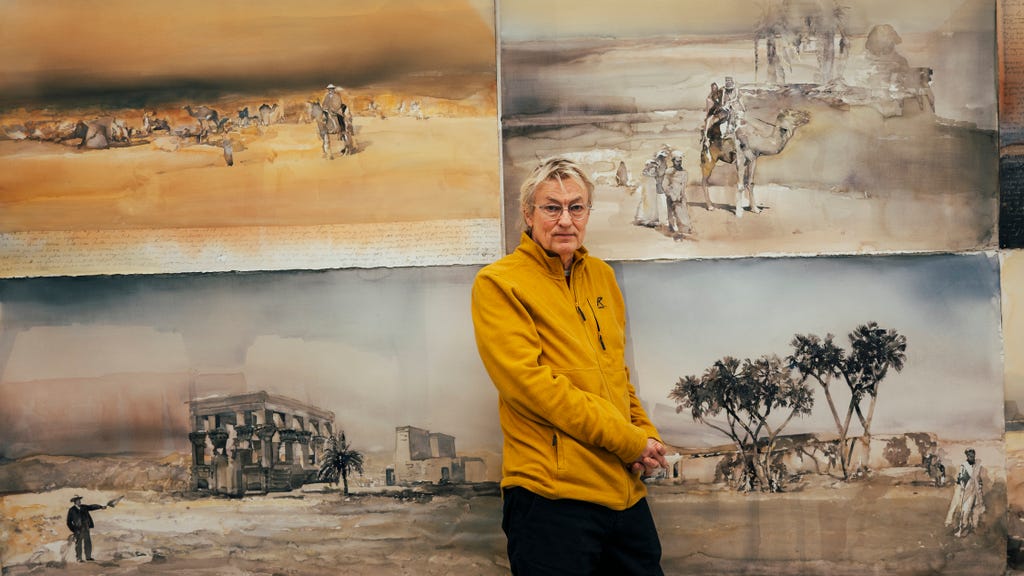The hustle and bustle within Stockholm’s Konstakademien was palpable as staff worked feverishly to rearrange Lars Lerin’s large watercolor paintings. Just the day before, the exhibition layout seemed finalized, but a late-night spark of inspiration from his gallerist, Angelika Knäpper, prompted a complete reshuffle, leaving the team racing against the clock to meet the public opening deadline. The repositioned artworks, now greeting visitors upon entering the gallery, are awash in the muted hues of the desert and aged photographs – ochre, sandstone, sepia – setting a distinct tone for the exhibition.
The genesis of this new collection lies in a serendipitous discovery. Lerin stumbled upon an antique photo album during an online auction, immediately recognizing its potential as a rich source of inspiration. The album, titled ”Resan till Egypten” (Journey to Egypt), 1904, documented the European and Egyptian travels of John Carlson, an enigmatic figure whose identity remains a mystery to Lerin. The faded photographs capture classic Egyptian tourist scenes: pyramids, sand dunes, locals, guides, and camels. However, compared to the throngs of modern tourism, these images are strikingly devoid of people, reminiscent of the deserted tourist sites witnessed during the pandemic. These strangely empty scenes captivated Lerin.
Lerin describes the photographs as resembling small watercolors, igniting in him a creative spark that he felt could sustain him for years. The album’s sepia tones offered a stark contrast to the blues and darker shades that had recently dominated his palette, challenging him to embrace a new luminous quality. The stark sunlight in many of the photographs, sometimes bleaching the paper white, and the darkened edges, caused perhaps by age or light leaks, resonated deeply with Lerin’s own artistic style. He recognized his own color palette and techniques reflected in these accidental artifacts of early photography. Even within the sun-drenched Egyptian landscapes, Lerin points out the menacing steel-blue skies lurking at the horizon, a detail he also often integrates into his work.
Beyond the twenty or so new paintings inspired by Carlson’s album, the Konstakademien exhibition, running from January 24th to March 8th, also showcases Lerin’s recent works depicting scenes from Värmland, Kiruna, and Lofoten. These pieces demonstrate the breadth of Lerin’s artistic reach and his ability to capture the essence of diverse landscapes. The inclusion of these works alongside the ”Ökenbilder” (Desert Pictures) series provides viewers with a comprehensive overview of Lerin’s recent artistic explorations.
Despite the exciting discovery of the photo album and the new direction it provided, Lerin’s creative process remained remarkably consistent. His daily routine, structured around family life and dedicated painting times, provided a stable foundation for his artistic explorations. He doesn’t seek out grand adventures or disruptions; his inspiration flows from the disciplined rhythm of his daily life. This constancy allows him to delve deep into his chosen subject matter, extracting the subtle nuances and translating them onto canvas with his characteristic sensitivity.
Beyond his studio practice, Lerin has become a familiar face on television. His latest series, ”Lerin på äldreboendet” (Lerin at the Nursing Home), follows his interactions with elderly dementia patients as they paint together, exploring the potential of art to unlock memories and emotions. While this project highlights Lerin’s compassionate nature and his belief in the therapeutic power of art, the current focus remains firmly on his exhibition. Lerin acknowledges a cyclical pattern in his work, where he eventually exhausts a particular theme after a few years, but often revisits it later with a fresh perspective. Even as he prepares for the opening of his latest exhibition, leafing through Carlson’s album reignites his passion for the Egyptian scenes, hinting at the enduring influence of this chance discovery. The ”Ökenbilder” series, while complete for this exhibition, represents a chapter in an ongoing dialogue between Lerin, the past, and the evocative power of found imagery.














